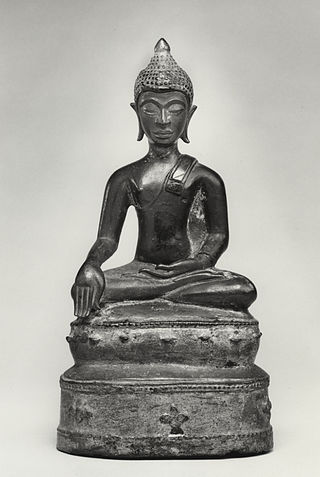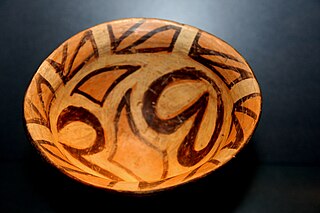Regions
Near East

The emergence of metallurgy may have occurred first in the Fertile Crescent.
Lead may have been the first ore that humans smelted, since it can be easily obtained by heating galena. [7]
Possible early examples of lead smelting, supported by the extreme rarity of native lead, [8] include: lead beads, found on Level IX of Chatal/Çatal Hüyük in central Anatolia, though they might be made of galena, cerussite, or metallic lead, and accordingly might or might not be evidence of early smelting; [9] [8] a lead bead, found in a GK59 group test square in the 4th level of Jarmo, dated to the 7th millennium BCE, though it is small enough that its human usage is doubtful; [10] a lead bracelet, found in level XII of Yarim Tepe I, dated to the 6th millennium BC; [11] [12] a small cone-shaped piece of lead, found in the "Burnt House" in TT6 at Arpachiyah, dated to the Halaf period or slightly later than the Yarim Tepe bracelet; [12] and more. [7]
Copper smelting is also documented at this site at about the same time period (soon after 6000 BC). However, the use of lead seems to precede copper smelting. [12] Early metallurgy is also documented at the nearby site of Tell Maghzaliyah, which seems to be dated even earlier, and completely lacks pottery.
The Timna Valley contains evidence of copper mining in 7000–5000 BC. The process of transition from Neolithic to Chalcolithic in the Middle East is characterized in archaeological stone tool assemblages by a decline in high quality raw material procurement and use. This dramatic shift is seen throughout the region, including the Tehran Plain, Iran. Here, analysis of six archaeological sites determined a marked downward trend in not only material quality, but also in aesthetic variation in the lithic artefacts. Fazeli & Coningham [13] use these results as evidence of the loss of craft specialisation caused by increased use of copper tools. [13]
The Tehran Plain findings illustrate the effects of the introduction of copper working technologies on the in-place systems of lithic craft specialists and raw materials. Networks of exchange and specialized processing and production that had evolved during the Neolithic seem to have collapsed by the Middle Chalcolithic (c. 4500–3500 BC) and been replaced by the use of local materials by a primarily household-based production of stone tools. [13]
Arsenical copper or bronze was produced in eastern Turkey (Malatya Province) at two ancient sites, Norşuntepe and Değirmentepe, around 4200 BC. According to Boscher (2016), hearths or natural draft furnaces, slag, ore, and pigment had been recovered throughout these sites. This was in the context of Ubaid period architectural complexes typical of southern Mesopotamian architecture. Norşuntepe site demonstrates that some form of arsenic alloying was indeed taking place by the 4th millennium BC. Since the slag identified at Norşuntepe contains no arsenic, this means that arsenic in some form was added separately. [14]
Europe
A copper axe found at Prokuplje, Serbia contains the oldest securely dated evidence of copper-making, c. 5500 BC (7,500 years ago). [15] The find in June 2010 extends the known record of copper smelting by about 800 years, and suggests that copper smelting may have been invented in separate parts of Asia and Europe at that time rather than spreading from a single source. [3]
Knowledge of the use of copper was far more widespread than the metal itself. The European Battle Axe culture used stone axes modeled on copper axes, even with moulding carved in the stone. [16] Ötzi the Iceman, who was found in the Ötztal Alps in 1991 and whose remains have been dated to about 3300 BC, was found with a Mondsee copper axe.

Examples of Chalcolithic cultures in Europe include Vila Nova de São Pedro and Los Millares on the Iberian Peninsula. [17] Pottery of the Beaker people has been found at both sites, dating to several centuries after copper-working began there. The Beaker culture appears to have spread copper and bronze technologies in Europe, along with Indo-European languages. [18] In Britain, copper was used between the 25th and 22nd centuries BC, but some archaeologists do not recognise a British Chalcolithic because production and use was on a small scale. [19]
South Asia
Ceramic similarities between the Indus Valley civilisation, southern Turkmenistan, and northern Iran during 4300–3300 BC of the Chalcolithic period suggest considerable mobility and trade. [20]
The term "Chalcolithic" has also been used in the context of the South Asian Stone Age. [21]
In Bhirrana, the earliest Indus civilization site, copper bangles and arrowheads were found. The inhabitants of Mehrgarh in present-day Pakistan fashioned tools with local copper ore between 7000 and 3300 BC. [22]
The Nausharo site was a pottery workshop in province of Balochistan, Pakistan, that dates to 4,500 years ago; 12 blades and blade fragments were excavated there. These blades are 12–18 cm (5–7 in) long, 1.2–2.0 cm (0.5–0.8 in) wide, and relatively thin. Archaeological experiments show that these blades were made with a copper indenter and functioned as a potter's tool to trim and shape unfired pottery. Petrographic analysis indicates local pottery manufacturing, but also reveals the existence of a few exotic black-slipped pottery items from the Indus Valley. [23]
In India, Chalcolithic culture flourished in mainly four farming communities – Ahar or Banas, Kayatha, Malwa, and Jorwe. These communities had some common traits like painted pottery and use of copper, but they had a distinct ceramic design tradition. Banas culture (2000–1600 BC) had ceramics with red, white, and black design. Kayatha culture (2450–1700 BC) had ceramics painted with brown colored design. Malwa culture (1900–1400 BC) had profusely decorated pottery with red or black colored design. Jorwe culture (1500–900 BC) had ceramics with matte surface and black-on-red design. [24] [25]
Pandu Rajar Dhibi (2000–1600 BC) is a Chalcolithic site in the eastern part of the Indian subcontinent. It is located on the south bank of Ajay River in West Bengal. Blackware, painted Koshi ware, pottery, various ornaments made of pearl and copper, various types of tools, pieces of fabric woven from Shimul cotton thread, human and various animal skeletons, burnt clay fragments have been found at the site. [26]
In March 2018, archaeologists had discovered three carts and copper artifacts including weapons dating to 1800 BC in Sanauli village of Uttar Pradesh. The artifacts belongs to Ochre Coloured Pottery culture. [27]
Pre-Columbian Americas
Andean civilizations in South America appear to have independently invented copper smelting. [28]
The term "Chalcolithic" is also applied to American civilizations that already used copper and copper alloys thousands of years before Europeans immigrated. Besides cultures in the Andes and Mesoamerica, the Old Copper complex mined and fabricated copper as tools, weapons, and personal ornaments in an area centered in the upper Great Lakes region (present-day Michigan and Wisconsin). [29]
The evidence of smelting or alloying that has been found in North America is subject to some dispute and a common assumption by archaeologists is that objects were cold-worked into shape. Artifacts from some of these sites have been dated to 6500–1000 BC, making them some of the oldest Chalcolithic sites in the world. [30] Some archaeologists find artifactual and structural evidence of casting by Hopewellian and Mississippian peoples to be demonstrated in the archaeological record. [31]
East Asia
This section needs additional citations for verification .(October 2018) |
In the 5th millennium BC copper artifacts start to appear in East Asia, such as in the Jiangzhai and Hongshan cultures, but those metal artifacts were not widely used during this early stage. [32]
Copper manufacturing gradually appeared in the Yangshao period (5000–3000 BC). Jiangzhai is the only site where copper artifacts were found in the Banpo culture. Archaeologists have found remains of copper metallurgy in various cultures from the late fourth to the early third millennia BC. These include the copper-smelting remains and copper artifacts of the Hongshan culture (4700–2900) and copper slag at the Yuanwozhen site. This indicates that inhabitants of the Yellow River valley had already learned how to make copper artifacts by the later Yangshao period. [33]
Sub-Saharan Africa
In the region of the Aïr Mountains, Niger, independent copper smelting developed between 3000 and 2500 BC. The process was not in a developed state, indicating smelting was not foreign. It became mature about 1500 BC. [34]











